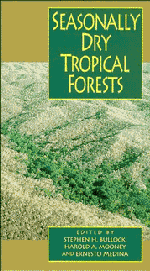Book contents
- Frontmatter
- Contents
- List of contributors
- Acknowledgements
- 1 Introduction
- 2 Dry forests of Central America and the Caribbean
- 3 Overview of the Brazilian caatinga
- 4 Savannas, woodlands and dry forests in Africa
- 5 Dry forest ecosystems of Thailand
- 6 The Cenozoic record of tropical dry forest in northern Latin America and the southern United States
- 7 Diversity and floristic composition of neotropical dry forests
- 8 Vertebrate diversity, ecology and conservation in neotropical dry forests
- 9 Diversity of life forms of higher plants in neotropical dry forests
- 10 Drought responses of neotropical dry forest trees
- 11 Plant reproduction in neotropical dry forests
- 12 Plant–herbivore interactions in Mesoamerican tropical dry forests
- 13 Biomass distribution and primary productivity of tropical dry forests
- 14 Nutrient cycling in tropical deciduous forests
- 15 Biology of the belowground system of tropical dry forests
- 16 Nitrogen trace gas emissions in a tropical dry forest ecosystem
- 17 Conversion of tropical dry forest to pasture and agriculture
- 18 Ethnobotany of the Mexican tropical dry forests
- Index
16 - Nitrogen trace gas emissions in a tropical dry forest ecosystem
Published online by Cambridge University Press: 07 September 2010
- Frontmatter
- Contents
- List of contributors
- Acknowledgements
- 1 Introduction
- 2 Dry forests of Central America and the Caribbean
- 3 Overview of the Brazilian caatinga
- 4 Savannas, woodlands and dry forests in Africa
- 5 Dry forest ecosystems of Thailand
- 6 The Cenozoic record of tropical dry forest in northern Latin America and the southern United States
- 7 Diversity and floristic composition of neotropical dry forests
- 8 Vertebrate diversity, ecology and conservation in neotropical dry forests
- 9 Diversity of life forms of higher plants in neotropical dry forests
- 10 Drought responses of neotropical dry forest trees
- 11 Plant reproduction in neotropical dry forests
- 12 Plant–herbivore interactions in Mesoamerican tropical dry forests
- 13 Biomass distribution and primary productivity of tropical dry forests
- 14 Nutrient cycling in tropical deciduous forests
- 15 Biology of the belowground system of tropical dry forests
- 16 Nitrogen trace gas emissions in a tropical dry forest ecosystem
- 17 Conversion of tropical dry forest to pasture and agriculture
- 18 Ethnobotany of the Mexican tropical dry forests
- Index
Summary
Introduction
The production and emission of trace gases from tropical forests are of interest for calculating global budgets, for determining local ecosystem mass balances, and for the insight they provide into ecosystem processes. Globally, tropical dry forests are widespread and functionally different from other biomes, and hence need to be characterized directly. More-over, the extent and intensity of human modification of dry forests (in comparison to other tropical biomes: Murphy & Lugo, 1986) raises the possibility that land use change in this biome could be globally significant in the concentration or distribution of one or more gases.
At the ecosystem level, loss to the atmosphere can be a major pathway of transfer of nitrogen and sulfur from terrestrial ecosystems (Likens et al., 1977; Bowden, 1986), and hence a possible determinant of the long-term fertility and potential productivity of terrestrial ecosystems. Since gaseous emissions are not normally included in watershed-level measurements of nutrient inputs and outputs, they can provide a useful complement to watershed studies. Finally, on the process level the trace gases emitted from terrestrial ecosystems represent either end products or by-products of fundamental metabolic processes that occur within terrestrial ecosystems. Their magnitude, timing and regulation provide insight into the operation of those processes even where emissions are not quantitatively significant in either global or local element budgets (Matson, Vitousek & Schimel, 1989).
None of these reasons is specific to tropical dry forests; all apply to any biome with a large areal extent and significant human modification. However, the dry forest biome is particularly interesting for three reasons. (1) It occupies an intermediate position on the great moisture gradient that underlies variation among tropical ecosystems (Medina, Chapter 9).
- Type
- Chapter
- Information
- Seasonally Dry Tropical Forests , pp. 384 - 398Publisher: Cambridge University PressPrint publication year: 1995
- 3
- Cited by



